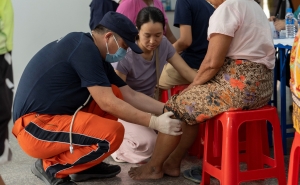How To Talk About Suicide
Suicide is a public health problem with major impacts. The ways in which it gets reported and talked about can help.

This article contains information about the concept of suicide. If you or someone you know is struggling with thoughts of self-harm, there are ways to get help. Call 1-800-273-TALK (8255) (en español 1-888-628-9454) for free, confidential crisis counseling and referrals available 24/7.
In one of her first reporting jobs, journalist Aneri Pattani worked the crime beat and occasionally covered suicides, which were lumped in with homicides and fires. After her first articles on suicides, she received feedback from prevention researchers, survivors, and people who had lost loved ones. They suggested using different phrasing, like “died by suicide” instead of “committed suicide,” and connected her with resources like Reporting On Suicide.
Pattani had received no specific training or guidance about how to write about suicide when she was in journalism school at Northeastern in 2013. Instead, she learned on the job thanks to the tips people sent her. Pattani is now a national correspondent covering mental health and suicide for Kaiser Health News. She is also an MPH student at the Bloomberg School, where she connected with suicide prevention researcher Holly Wilcox, PhD, a professor in Mental Health, to share existing guidelines, the research behind them, and practical tips on how to apply them in a free Coursera course Responsible Reporting on Suicide for Journalists.
But the curriculum isn’t just for reporters. “All of us can use tips on how we communicate with each other” about suicide, Pattani said in an episode of Public Health On Call.
In fact, the language we use to talk about suicide, how we frame the issue, the content that gets shared on the web and social media can affect what happens next—specifically, whether it contributes to more deaths or prevents them.
Suicide Is a Public Health Issue
Often laden with religious or moral stigma, suicide is an uncomfortable topic for many people. “In society, we at one point looked at it as a crime,” Pattani said, referencing her work on the crime beat.
The course sets out by framing suicide as a public health problem. “That sounds really basic,” Pattani said, “but a lot of people haven’t taken the time to think about suicide in that way.”
Consider the scope: Suicide is the 10th leading cause of death in the U.S. for adults. In 2020 alone, nearly 46,000 people died by suicide with an estimated 1.2 million attempts. For teenagers, it’s the second leading cause of death behind unintentional injuries. 2019 data shows 6,488 deaths by suicide among young people aged 10 to 24. Prior to 2019, most suicides in the U.S. were among white, middle-aged males. Although overall suicide rates declined slightly after 2018, during COVID, suicides among racial minorities increased “significantly.” There’s also evidence that veterans, people who live in rural areas, sexual and gender minorities, and tribal populations are at an increased risk of suicide.
These are big numbers, but suicide’s impacts aren’t measured in deaths alone. People who lose loved ones to suicide face their own mental health impacts, including trauma, grief, or even stigma and shame. Suicide attempts also account for significant impacts on individuals including mental, physical, and financial costs.
These are the population-level impacts, Pattani said, but the causes can be population-level too. “When you step back and look at what causes suicide—the risk factors—those are also population-level things like housing, jobs, and the economic status of the country [as well as] racial discrimination and bias,” she said.
“Looking at both the causes and the impacts, it becomes clear that suicide is a public health issue and has to be dealt with at the population level, but a lot of people don’t know that because we haven’t had that conversation society-wide.”
How We Talk About Suicide Matters
The course is designed to help reporters understand how impactful media can be on suicide trends and the power of responsible reporting to improve public health.
Extensive research shows that news coverage of suicide is associated with spikes in subsequent suicide deaths among the public.
A 1974 study on the influence of suggestion found that “suicides increase immediately after a suicide story has been publicized. … The more publicity devoted to a suicide story, the larger the rise in suicides thereafter … restricted mainly to the area in which the suicide was published.” A 2018 study found that “repetitive reporting of the same suicide … [was] positively associated with suicide rates.”
“This is not to say that any coverage of suicide is bad,” Pattani explained. “In some newsrooms, they don’t write about it or talk about it at all. That’s not what the research and guidelines are saying.”
In fact, not talking or writing about suicide allows shame and stigma to creep in. The more suicide is discussed—thoughtfully and using evidence-based guidelines—the more we as a society become skilled in handling these difficult conversations. Effective reporting can increase the likelihood that people will seek help, which is why both the WHO and the CDC have identified responsible reporting as a key tool in preventing suicide.
“It’s really more about how we frame stories around suicide, and is it just dramatic and [a] tragedy, and just the idea of this problem existing or we are putting in actional information about hope, or resilience, or treatment?” Pattani said.
Public Health On Call
This article was adapted from the June 15 episode of Public Health On Call Podcast.
Some Guidelines For Writing and Talking About Suicide
The course provides more details about best practices, but here are a few takeaways:
Report suicide as a public health issue.
Framing suicide as a public health issue means not reporting it as a crime or a breaking news story. Keeping the information general—without speculation, blame, or shame—is key as is focusing on suicide, not as an individual problem with individual solutions.
“This means articles go beyond reporting a single suicide death in the way we might a single car accident,” Pattani said, “Instead, provide context for readers about the societal cost and impact of suicide, similarly to including a paragraph about how many car accidents happen in the country each year, if people of certain ages or those driving in certain cities are a greater risk, and how things like wearing a seatbelt can help protect you.”
Carefully consider language.
“Historically, we’d say someone ‘committed’ suicide,” Pattani said, but now the preferred wording is that “someone died by suicide.” This strips away connections to crime and sin—“you commit a crime, you commit a sin. But when someone dies from cancer, we say ‘they died from cancer.’”
Also, avoid terms like “successful” or “failed” in describing suicide attempts, as these terms can lead to further stigma.
Exclude certain details.
Avoid talking about the method or location of death, Pattani said, because for people who may be struggling, this can lead to action. “Individuals dealing with mental illness or having thoughts of suicide may identify with the person in your story…it can actually be enough to trigger them to action, giving them enough information about how to act upon thoughts they already have.”
Include resources.
Suicide coverage offers an opportunity to connect people with resources. That’s why it’s common to see reports with a content warning and/or ways to seek help if the reader or someone they know is thinking about harming themselves.
Pattani said it’s best to put this information at the top of a story so even if the reader doesn’t finish the article, important resources and links are front and center.
Emphasize help and hope.
Talking about suicide opens the door to talking about recovery for people who have been at risk for self-harm. Stories about help-seeking and positive coping skills can be powerfully suggestive.
Learn more about the course here and see more recommendations and guidelines for reporting on suicide here.
Lindsay Smith Rogers, MA, is the producer of the Public Health On Call podcast and the associate director of content strategy for the Johns Hopkins Bloomberg School of Public Health.





